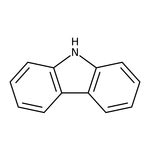Search Thermo Fisher Scientific
Carbazol, 95 %, Thermo Scientific Chemicals



Carbazol, 95 %, Thermo Scientific Chemicals
Chemikalien-Kennzeichnungen
Spezifikationen
Beschreibung
This Thermo Scientific Chemicals brand product was originally part of the Alfa Aesar product portfolio. Some documentation and label information may refer to the legacy brand. The original Alfa Aesar product / item code or SKU reference has not changed as a part of the brand transition to Thermo Scientific Chemicals.
Carbazol und seine Derivate werden häufig als Zwischenprodukt bei der Synthese von Pharmazeutika, Agrochemikalien, Farbstoffen, Pigmenten und anderen organischen Verbindungen verwendet. Carbazol wird auch in der Lumineszenzchemie als photosensibilisierendes und zusätzliches Ladungstransportmaterial verwendet. Die Carbazolstruktur ist ein Motiv in Pharmazeutika wie Carvedilol, das zur Behandlung von Bluthochdruck und zur Verhinderung von Herzrhythmusstörungen und Angina pectoris eingesetzt wird.
Löslichkeit
Es ist unlöslich in Wasser.
Hinweise
Stabil unter normalen Bedingungen. Kühl lagern. Behälter an einem trockenen und gut belüfteten Ort dicht verschlossen halten.
Abbildungen
Dokumente und Downloads
Zertifikate
Häufig gestellte Fragen (FAQ)
Zitierungen und Referenzen
Sicherheit und Handhabung
Classification of the substance or mixture
CLP classification - Regulation(EC) No 1272/2008
Label Elements
Signal Word
Warning
Hazard Statements
H315 - Causes skin irritation
H319 - Causes serious eye irritation
H335 - May cause respiratory irritation
H351 - Suspected of causing cancer
H410 - Very toxic to aquatic life with long lasting effects
Precautionary Statements
P261 - Avoid breathing dust/fume/gas/mist/vapors/spray
P273 - Avoid release to the environment
P305 + P351 + P338 - IF IN EYES: Rinse cautiously with water for several minutes. Remove contact lenses, if present and easy to do. Continue rinsing
P280 - Wear protective gloves/protective clothing/eye protection/face protection
P332 + P313 - If skin irritation occurs: Get medical advice/attention
P337 + P313 - If eye irritation persists: Get medical advice/attention